Abstract
A material with thyrotropic activity was extracted from fresh human placentas. After chromatography of the extract on carboxymethyl cellulose, thyroid-stimulating activity ranged from 0.12 to 1.06 mU of thyroid-stimulating hormone (TSH) per mg of protein in bioassays of eight preparations. The amount of TSH per placenta varied from 113 to 2200 mU and approximated the content of the pituitary gland. Additional purification by gel filtration on Sephadex G-100 gave a maximum activity of 8 mU/mg. The most active portion was eluted in the same position as 125I-labeled bovine or human TSH, a fact suggesting that the molecular size of this thyrotropic substance was similar to that of pituitary TSH. Another placental fraction with weaker activity was eluted earlier indicating that the placental material was heterogeneous.
In the McKenzie mouse bioassy, the response of the placental thyrotropin paralleled that of the beef TSH standard. There was no long-acting thyroid stimulator effect. Antibodies to both human and bovine pituitary TSH neutralized the biologic activity of the placental TSH. Placental thyrotropin cross-reacted very weakly in a sensitive radioimmunoassay for human pituitary TSH; it cross-reacted completely in a radioimmunoassay for bovine pituitary TSH, and this assay was used for following the purification. The role of this thyrotropic material as a possible cause of thyroid hypertrophy and hyperfunction in pregnancy and in patients with trophoblastic tumors remains to be investigated.
Full text
PDF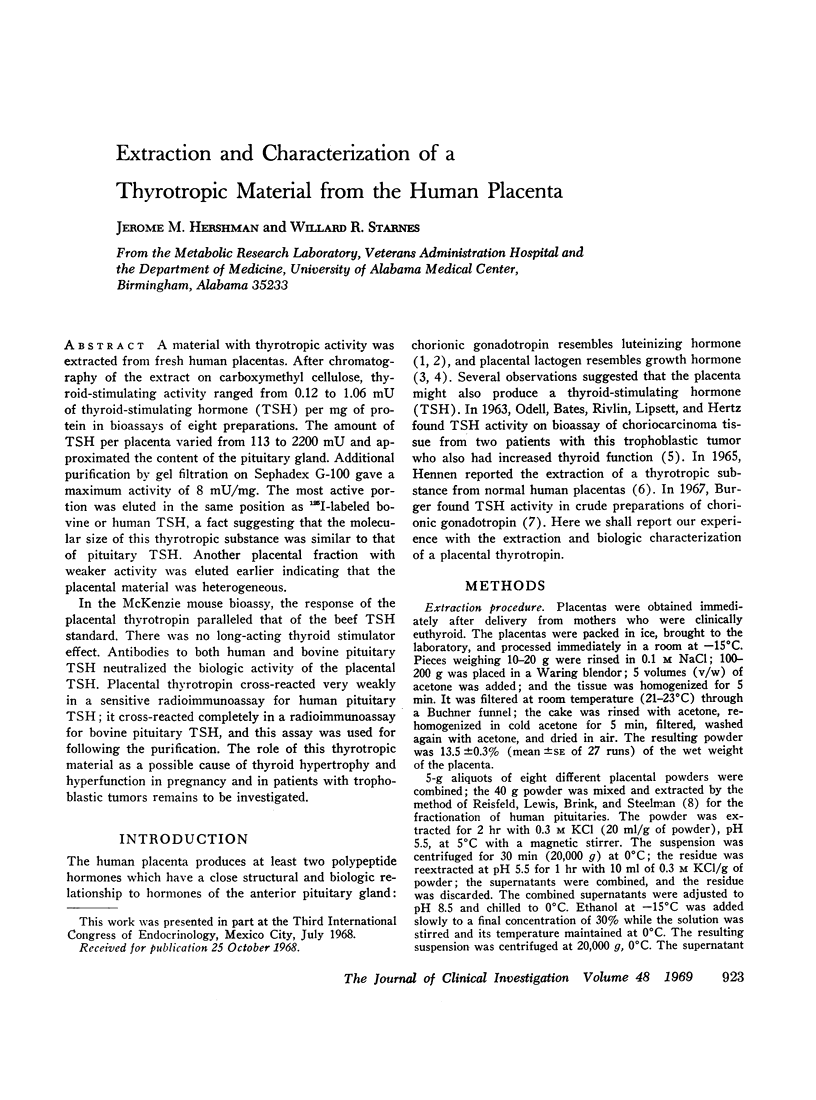
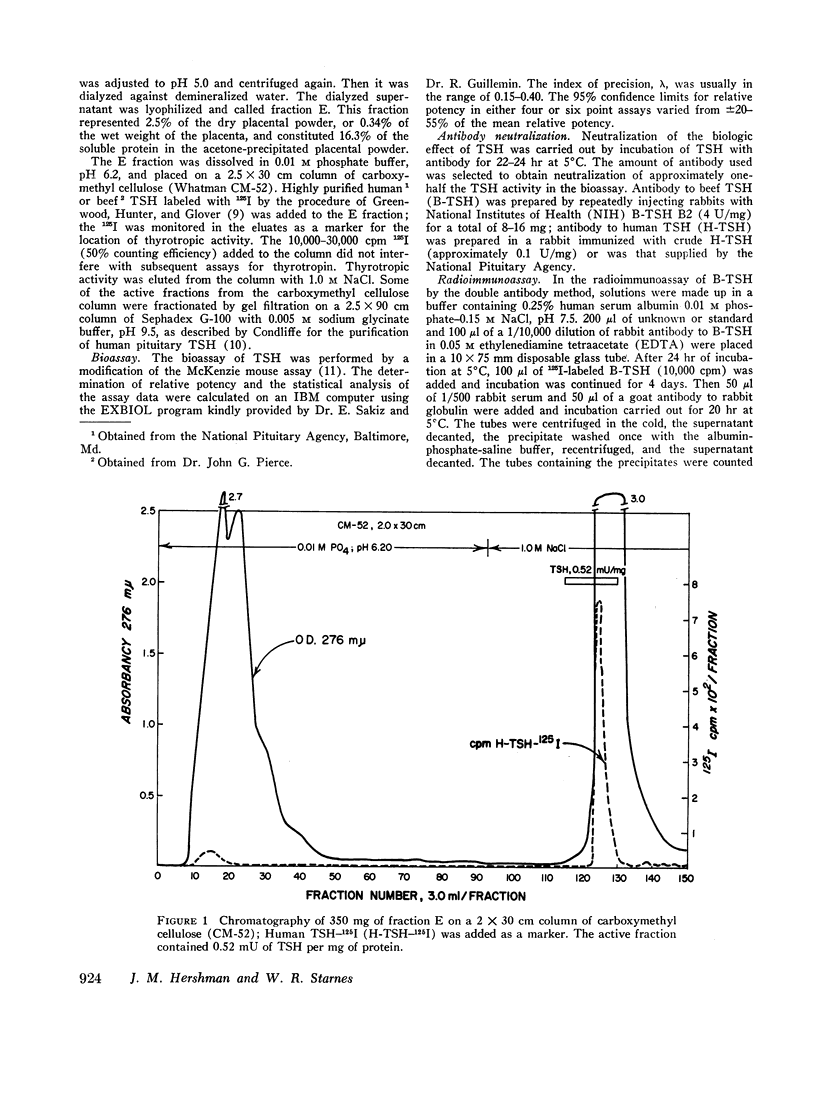
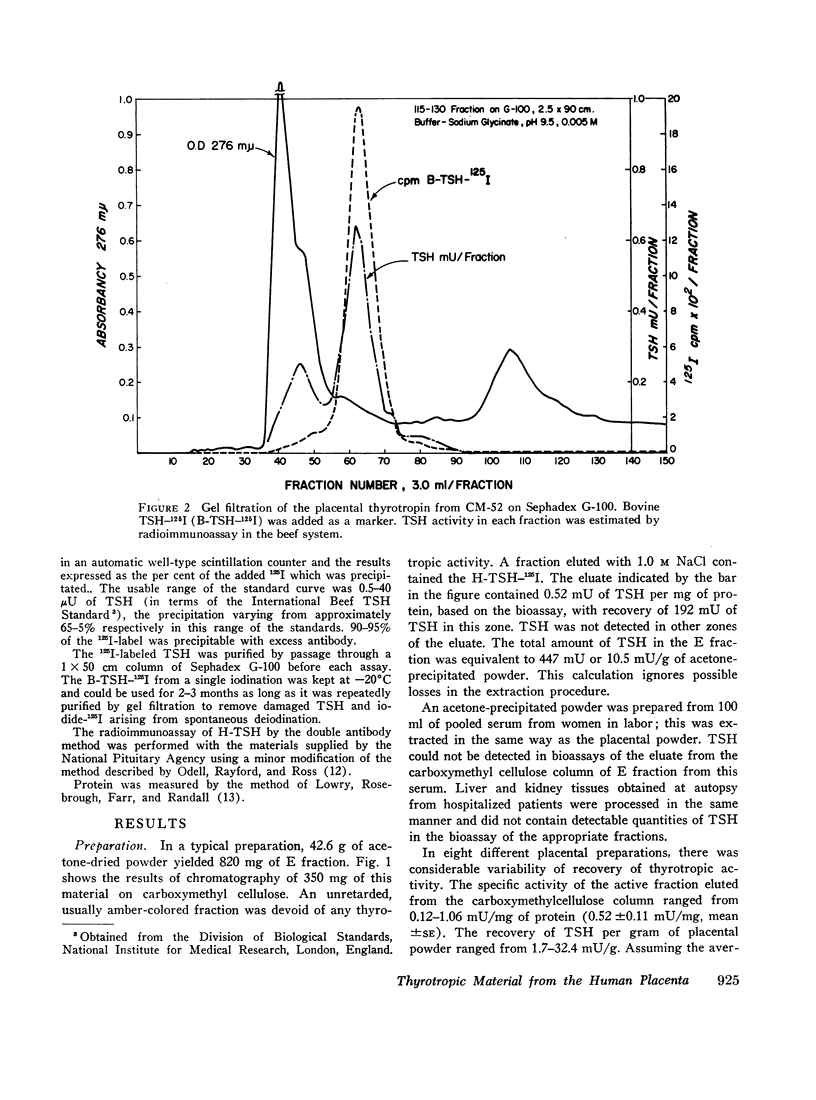
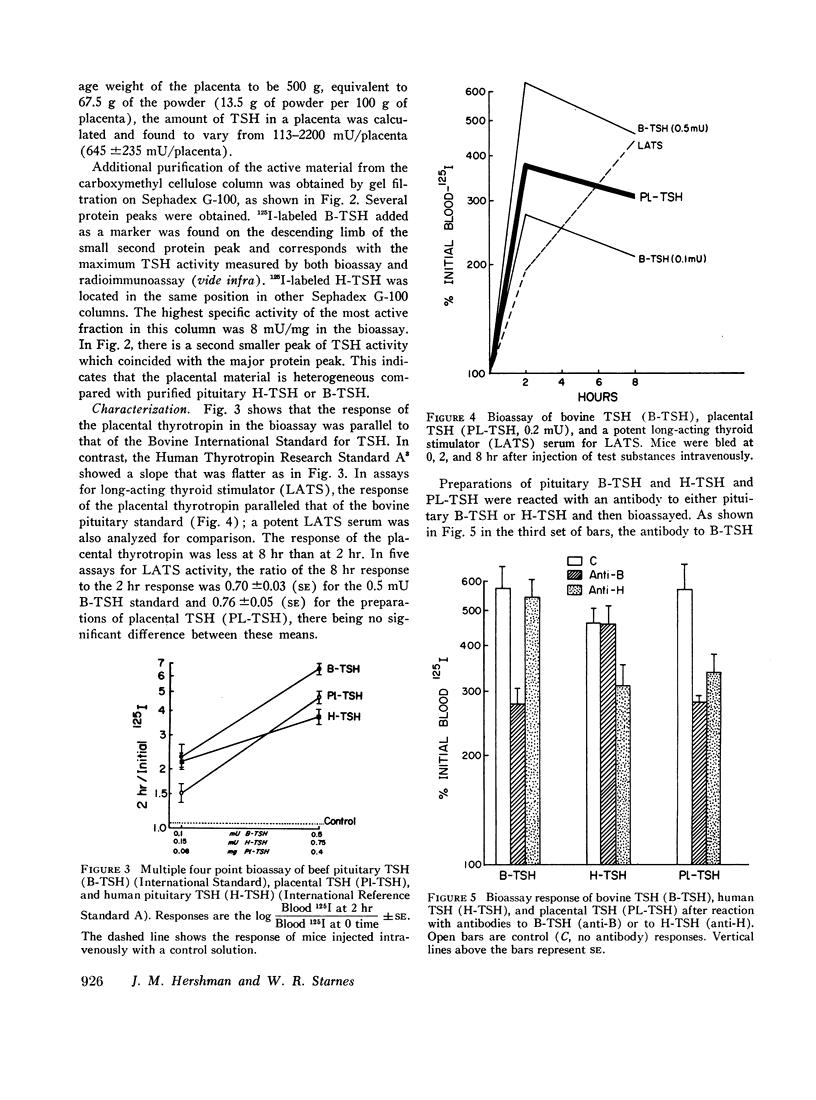
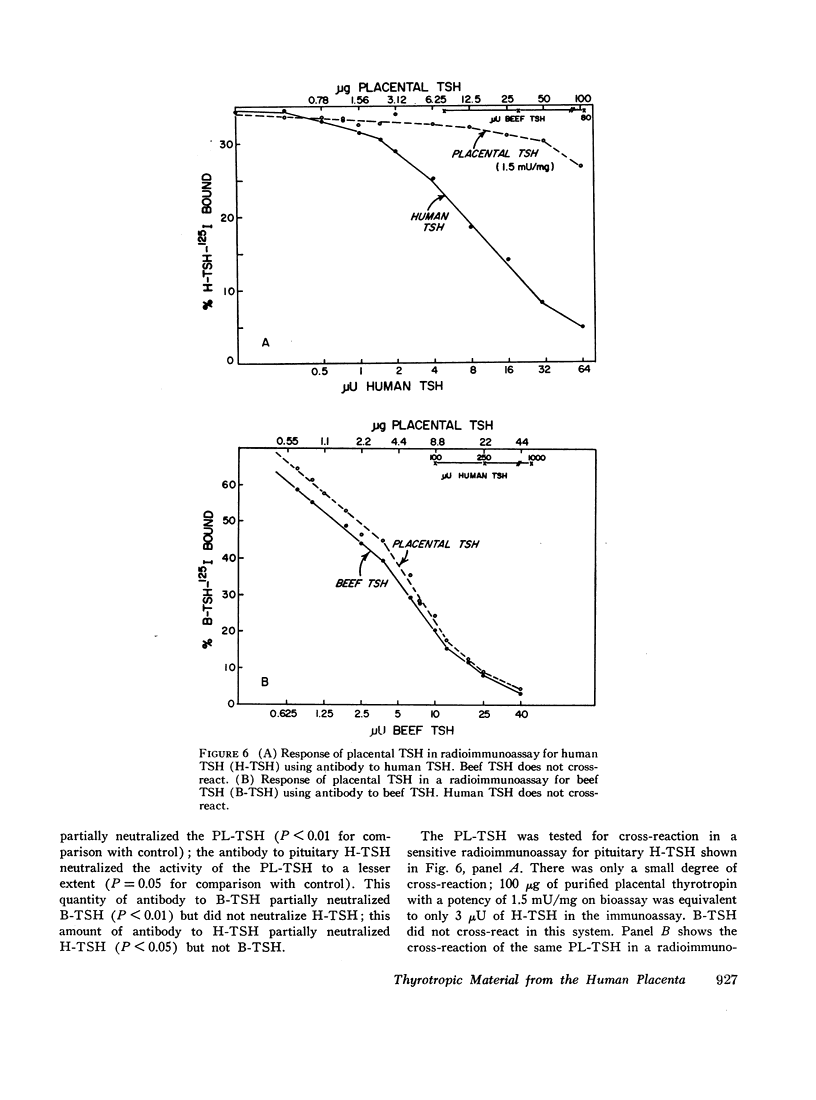

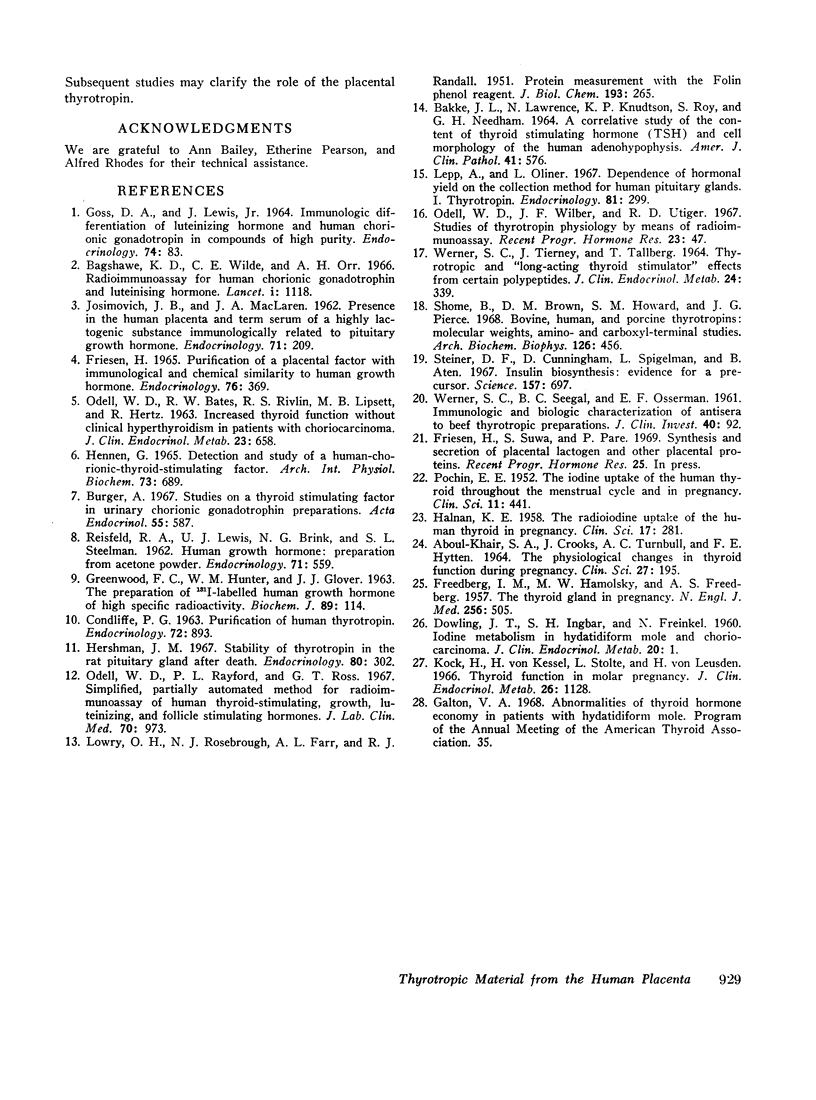
Selected References
These references are in PubMed. This may not be the complete list of references from this article.
- ABOUL-KHAIR S. A., CROOKS J., TURNBULL A. C., HYTTEN F. E. THE PHYSIOLOGICAL CHANGES IN THYROID FUNCTION DURING PREGNANCY. Clin Sci. 1964 Oct;27:195–207. [PubMed] [Google Scholar]
- BAKKE J. L., LAWRENCE N., KNUDTSON K. P., ROY S., NEEDHAM G. H. A CORRELATIVE STUDY OF THE CONTENT OF THYROID STIMULATING HORMONE(TSH) AND CELL MORPHOLOGY OF THE HUMAN ADENOHYPOPHYSIS. Am J Clin Pathol. 1964 Jun;41:576–588. doi: 10.1093/ajcp/41.6.576. [DOI] [PubMed] [Google Scholar]
- Bagshawe K. D., Wilde C. E., Orr A. H. Radioimmunoassay for human chorionic gonadotrophin and luteinising hormone. Lancet. 1966 May 21;1(7447):1118–1121. doi: 10.1016/s0140-6736(66)91136-6. [DOI] [PubMed] [Google Scholar]
- Burger A. Studies on a thyroid stimulating factor in urinary chorionic gonadotrophin preparations. Acta Endocrinol (Copenh) 1967 Aug;55(4):587–599. doi: 10.1530/acta.0.0550587. [DOI] [PubMed] [Google Scholar]
- CONDLIFFE P. G. Purification of human thyrotrophin. Endocrinology. 1963 Jun;72:893–896. doi: 10.1210/endo-72-6-893. [DOI] [PubMed] [Google Scholar]
- DOWLING J. T., INGBAR S. H., FREINKEL N. Iodine metabolism in hydatidiform mole and choriocarcinoma. J Clin Endocrinol Metab. 1960 Jan;20:1–12. doi: 10.1210/jcem-20-1-1. [DOI] [PubMed] [Google Scholar]
- FREEDBERG I. M., HAMOLSKY M. W., FREEDBERG A. S. The thyroid gland in pregnancy. N Engl J Med. 1957 Mar 14;256(11):505–contd. doi: 10.1056/NEJM195703142561106. [DOI] [PubMed] [Google Scholar]
- FRIESEN H. PURIFICATION OF A PLACENTAL FACTOR WITH IMMUNOLOGICAL AND CHEMICAL SIMILARITY TO HUMAN GROWTH HORMONE. Endocrinology. 1965 Mar;76:369–381. doi: 10.1210/endo-76-3-369. [DOI] [PubMed] [Google Scholar]
- GOSS D. A., LEWIS J., Jr IMMUNOLOGIC DIFFERENTIATION OF LUTEINIZING HORMONE AND HUMAN CHORIONIC GONADOTROPIN IN COMPOUNDS OF HIGH PURITY. Endocrinology. 1964 Jan;74:83–86. doi: 10.1210/endo-74-1-83. [DOI] [PubMed] [Google Scholar]
- GREENWOOD F. C., HUNTER W. M., GLOVER J. S. THE PREPARATION OF I-131-LABELLED HUMAN GROWTH HORMONE OF HIGH SPECIFIC RADIOACTIVITY. Biochem J. 1963 Oct;89:114–123. doi: 10.1042/bj0890114. [DOI] [PMC free article] [PubMed] [Google Scholar]
- HALNAN K. E. The radioiodine uptake of the human thyroid in pregnancy. Clin Sci. 1958;17(2):281–290. [PubMed] [Google Scholar]
- Hennen G. Detection and study of a human-chorionic-thyroid-stimulating factor. Arch Int Physiol Biochim. 1965 Sep;73(4):689–695. doi: 10.3109/13813456509084890. [DOI] [PubMed] [Google Scholar]
- Hershman J. M. Stability of thyrotropin in the rat pituitary gland after death. Endocrinology. 1967 Feb;80(2):302–304. doi: 10.1210/endo-80-2-302. [DOI] [PubMed] [Google Scholar]
- JOSIMOVICH J. B., MACLAREN J. A. Presence in the human placenta and term serum of a highly lactogenic substance immunologically related to pituitary growth hormone. Endocrinology. 1962 Aug;71:209–220. doi: 10.1210/endo-71-2-209. [DOI] [PubMed] [Google Scholar]
- Kock H., von Kessel H., Stolte L., von Leusden H. Thyroid function in molar pregnancy. J Clin Endocrinol Metab. 1966 Oct;26(10):1128–1134. doi: 10.1210/jcem-26-10-1128. [DOI] [PubMed] [Google Scholar]
- LOWRY O. H., ROSEBROUGH N. J., FARR A. L., RANDALL R. J. Protein measurement with the Folin phenol reagent. J Biol Chem. 1951 Nov;193(1):265–275. [PubMed] [Google Scholar]
- Lepp A., Oliner L. Dependence of hormonal yield on the collection method for human pituitary glands. I. Thyrotropin. Endocrinology. 1967 Aug;81(2):299–305. doi: 10.1210/endo-81-2-299. [DOI] [PubMed] [Google Scholar]
- ODELL W. D., BATES R. W., RIVLIN R. S., LIPSETT M. B., HERTZ R. Increased thyroid function without clinical hyperthyroidism in patients with choriocarcinoma. J Clin Endocrinol Metab. 1963 Jul;23:658–664. doi: 10.1210/jcem-23-7-658. [DOI] [PubMed] [Google Scholar]
- Odell W. D., Rayford P. L., Ross G. T. Simplified, partially automated method for radioimmunoassay of human thyroid-stimulating, growth, luteinizing, and follicle stimulating hormones. J Lab Clin Med. 1967 Dec;70(6):973–980. [PubMed] [Google Scholar]
- Odell W. D., Wilber J. F., Utiger R. D. Studies of thyrotropin physiology by means of radioimmunoassay. Recent Prog Horm Res. 1967;23:47–85. doi: 10.1016/b978-1-4831-9826-2.50005-2. [DOI] [PubMed] [Google Scholar]
- POCHIN E. E. The iodine uptake of the human thyroid throughout the menstrual cycle and in pregnancy. Clin Sci. 1952 Nov;11(4):441–445. [PubMed] [Google Scholar]
- REISFELD R. A., LEWIS U. J., BRINK N. G., STEELMAN S. L. Human growth hormone: preparation from acetone powder. Endocrinology. 1962 Oct;71:559–563. doi: 10.1210/endo-71-4-559. [DOI] [PubMed] [Google Scholar]
- Shome B., Brown D. M., Howard S. M., Pierce J. G. Bovine, human and porcine thyrotropins: molecular weights, amino- and carboxyl-terminal studies. Arch Biochem Biophys. 1968 Aug;126(2):456–468. doi: 10.1016/0003-9861(68)90430-x. [DOI] [PubMed] [Google Scholar]
- Steiner D. F., Cunningham D., Spigelman L., Aten B. Insulin biosynthesis: evidence for a precursor. Science. 1967 Aug 11;157(3789):697–700. doi: 10.1126/science.157.3789.697. [DOI] [PubMed] [Google Scholar]
- WERNER S. C., SEEGAL B. C., OSSERMAN E. F. Immunologic and biologic characterization of antisera to beef thyrotropin preparations. J Clin Invest. 1961 Jan;40:92–104. doi: 10.1172/JCI104241. [DOI] [PMC free article] [PubMed] [Google Scholar]
- WERNER S. C., TIERNEY J., TALLBERG T. THYROTRO IC AND "LONG-ACTING THYROID STIMULATOR" EFFECTS FROM CERTAIN POLYPEPTIDES. J Clin Endocrinol Metab. 1964 Apr;24:339–346. doi: 10.1210/jcem-24-4-339. [DOI] [PubMed] [Google Scholar]


